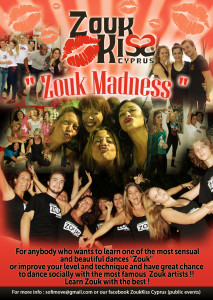
Zouk Music
Zouk is a style of rhythmic music originating from the Caribbean islands of Guadeloupe & Martinique. Zouk means “party” or “festival” in the local Antillean Creole of French, although the word originally referred to, and is still used to refer to, a popular dance, based on the Polish dance, the mazurka, that was introduced to the French Caribbean in the 19th Century.
Zouk-Lambada
Zouk-Lambada (also called Brazilian Zouk) is a group of closely related dance styles based on or evolved from the lambada dance style and is typically danced to zouk music or other music containing the zouk beat. The name Brazilian Zouk is used to distinguish the dance from the Caribbean Zouk dance, which is very different from the Zouk-Lambada dance. When practicing Zouk-Lambada in dance classes, teachers generally warn women to be very careful with their backs and necks, as two of the most distinctive and commented-on movements are the cambré (arching backwards to a greater or lesser degree, sometimes even below the waist) and the specific ‘hair movements’ or ‘ head movements’ for the woman.
The two dominant styles of Zouk-Lambada are the Porto-Seguro style and the Rio-style. Unlike salsa, which is led with the hands; Brazilian zouk is led by more parts of the body, noticeably the glued-to-each-other hips of the partners. Thus, in a basic sideways movement, it is the hips that move first, followed by the rest of the body, and this is part of what makes the dance so sensual. However, in various moves the dance partners are also connected by eye contact, legs, arms, shoulders, head, etc.
Porto Seguro-style (sometimes still called lambada)
Porto Seguro-style is a fast and energetic dance, it flows smoothly and the moves are continuous and the dancers are constantly orbiting around the partner(s). It is mainly danced in North-East Brazil (Porto Seguro), Argentina, Spain, the UK, the west coast of the US, Israel, Japan & recently also in Malaysia. The Porto-Seguro style is very close to the original Lambada from which it derives. It is characterised by:
- up-tempo music
- whip-like movements of the body
- 1,2,3=”quick-quick-slow” counting
Rio-style Zouk
Rio-style Zouk was first developed in the Ilha Dos Pescadores in Rio de Janeiro around 1989. It is mainly danced in Brazil, Australia, The Netherlands, Spain and some other European countries. It uses a modified, slower, smoother, even more sensual version of the lambada and often incorporates elements of contemporary dance and contact improvisation. It is typically danced on Zouk-love style music but it is also danced on R&B, Latin pop and Arabic music, mixed with a zouk music beat.
Which style?
The Porto Seguro-style differs from the Rio-style in the way the steps are performed on the music. To put it simply, Rio-style zouk is danced on the dominant beat (3,1,2), while Porto Seguro-style is danced on the small beats (1,2,3). In general the Porto Seguro-style is more suitable for fast tempo music, whereas Rio style zouk is more suitable for slow tempo music. It is also very common practice to switch fluently between these dancing styles during a single Zouk music song.